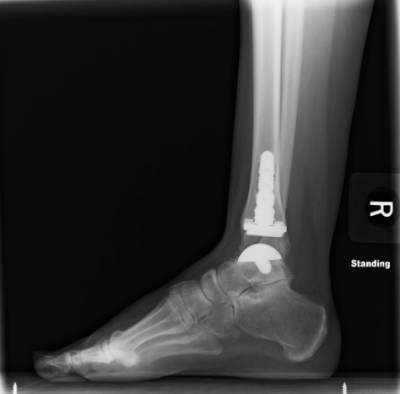
Ankle Replacement
Total Ankle Arthroplasty
What is total ankle arthroplasty?
Total ankle arthroplasty (TAA), also known as total ankle replacement, is a surgical procedure that orthopedic foot and ankle surgeons use to treat ankle arthritis. Arthritic changes may be a result of normal wear and tear due to aging or from an injury such as a broken ankle or dislocation. Arthritis eventually leads to loss of cartilage, pain and/or deformity.
What are the goals of TAA?
The goal of TAA is to improve ankle motion so the patient has less pain during activity.
What signs indicate TAA may be needed?
TAA is considered in patients that experience ankle pain and decreased function from arthritis after trying conservative management. Conservative management includes anti-inflammatory medication, bracing, physical therapy, activity modification and pain medication. Patients with rheumatoid arthritis are usually good candidates for the ankle joint replacement. Other patients that should be considered are those that need but do not want a fusion-type procedure that would eliminate the motion at the ankle joint.
When should I avoid a TAA?
TAA is not suited for patients with significant deformity or dead bone in the talus, which is the bottom bone of the ankle joint. Prior or current infections of the ankle, significant lower extremity neuropathy, inadequate or absent leg muscle function, poor blood flow of the leg, or inadequate soft tissues are also signs that TAA should be avoided.
General Details of Procedure
TAA is performed either under general anesthetic or nerve block. A tourniquet is used at the time of surgery to control bleeding and improve visualization during the surgery. The ankle is approached from the front or the side depending on the type of implant being used. Bone is then cut, allowing for placement of the metal and plastic components that re-create the ankle joint. Sometimes the patient will have a tight calf muscle or tight Achilles tendon that needs to be lengthened to improve range of motion of the ankle. The wounds are then closed using stitches or staples, and a splint is applied. A period of non-weightbearing in either a cast or cast boot is necessary to allow the implants to heal in place.
Specific Technique
Either before or after the ankle replacement is put in place, the orthopaedic foot and ankle surgeon will determine if the calf muscle or Achilles is tight. A tight calf muscle or Achilles tendon is addressed with a lengthening procedure. This is important to improve motion after the surgery, as well as to take stress off the ankle replacement.
What happens after surgery?
Recovery from a total ankle replacement requires a period of non-weightbearing and immobilization. The procedure is usually performed in an inpatient setting, with the patient spending one to several nights in the hospital. Strict elevation for many days after the procedure is necessary to control swelling and improve wound healing. After the surgical wounds are healed, some orthopedic foot and ankle surgeons will allow the patient to start working on gentle range-of-motion activities even if they are non-weightbearing. Weightbearing usually begins a few weeks after surgery if X-rays show good healing.
Potential Complications
There are complications that relate to surgery in general. These include the risks associated with anesthesia, infection, damage to nerves and blood vessels, and bleeding or blood clots.
Fracture of bone on either side of the total ankle implant is the most common complication. Injury to tendons or nerves and blood vessels is also a possible complication of ankle replacement. Wound healing can be a problem in patients that smoke or have diabetes, or in patients that have rheumatoid arthritis. Another complication that is sometimes seen is the failure of the ankle implant to heal into the bone.
Frequently Asked Questions
There are two surgical approaches for treatment of arthritis: ankle fusion and total ankle replacement. Why should I consider an ankle replacement?
When motion of the ankle is preserved in a TAA, the surrounding joints are protected from increased wear. This helps preserve the surrounding joints from arthritis. It is usual for people with ankle fusions to have progressive arthritis in the surrounding joints in about 10 to 15 years.
The number of ankle replacements being performed is increasing dramatically. This is a result of improved outcomes. Newer implant designs and improved surgical techniques are helping patients be more active after a TAA than they were previously.
Who should I see to have a total ankle replacement?
An orthopedic foot and ankle surgeon should be seen for management of ankle arthritis. Orthopedic surgeons who specialize in foot and ankle surgery are specifically trained to perform ankle replacements as well as take care of any complications should they arise.




